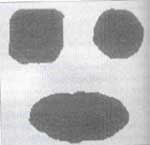Humanising machines
 OFTEN, a question elicits the cryptic "maybe" as the reply. The fuzzy logic behind such an answer has not escaped mathematicians who have built a mathematical theory known as fuzzy set theory around it. Considering the nebulous character of such logic, the benefits accruing from it are nothing less than fabulous -- this theory is being incorporated into computers for applications as diverse as remote sensing and forensic finger-printing.
OFTEN, a question elicits the cryptic "maybe" as the reply. The fuzzy logic behind such an answer has not escaped mathematicians who have built a mathematical theory known as fuzzy set theory around it. Considering the nebulous character of such logic, the benefits accruing from it are nothing less than fabulous -- this theory is being incorporated into computers for applications as diverse as remote sensing and forensic finger-printing.
And recently, Sankar Pal and his colleagues at the Indian Statistical Institute in Calcutta have used the fuzzy set theory to develop a computer algorithm -- known as an artificial neural network -- that mimics the way the human brain works and can be used to diagnose disease.
Explains Pal, "Human beings think or act in a fuzzy manner which do not have defined boundaries. We select an object as beautiful or appropriate based on some undefined logic and most of the time it works well. But, the computer's logic known as 'digital logic' is limited to a 'yes' or 'no' level of decision making. Computers take decisions based on pre-defined boundaries and they move on to the next level of operation by responding to these definitions. If the given object is not in the pre-defined set, the computer gets confused and selects the wrong one."
This fuzzy logic, if developed into a computer programme, provides machines with artificial intelligence and adds to their efficiency. For instance, a defence computer receives a satellite image of some area on earth and has to decide between whether it is a water body, agricultural area or road and send the response for further action. If the image is not clear, the computer either chooses the option which is the closest to the image or it drops the valuable image for the want of clarity. Ideally, the computer should send the response with a warning of uncertainty as human beings do.
Pal and his colleagues were able to incorporate such logic into their artificial neural network to diagnose disease. They first trained their network with kala-azar symptoms from 30 people -- 10 control and 20 diseased -- and then tested it with 38 samples. They have shown that the network is suitable in inferring correct decisions in the presence of overlapping disease categories. Claims Pal, "The advantage with this network is that it works well with incomplete symptoms and it decides and justifies the decision."
The scientists now plan to develop this technology to manufacture intelligent consumer items like colour televisions capable of self-adjusting the colour and washing machines that can adjust the speed and water level automatically depending upon how dirty the clothes are.
